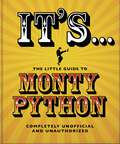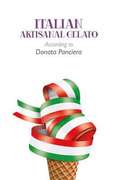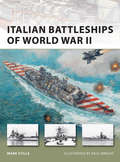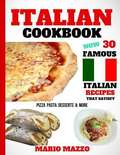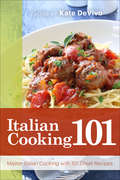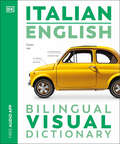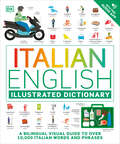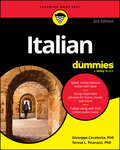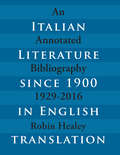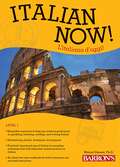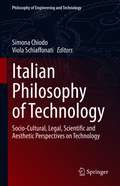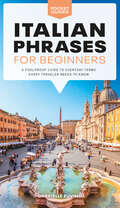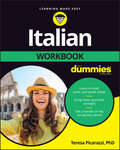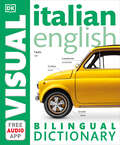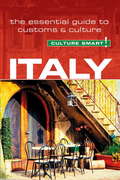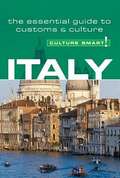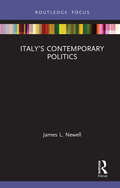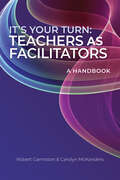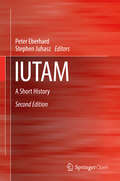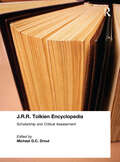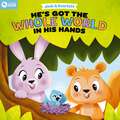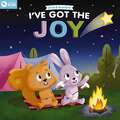- Table View
- List View
It's... The Little Guide to Monty Python: ... And Now For Something Completely Different (The\little Book Of... Ser.)
by Orange Hippo!Made from the paper of the mightiest tree in a forest and cut to size with a herring, this Little Guide to Monty Python may be only-ever-so slightly bigger than one of Mr Creosote's wafer-sized mints, but it's packed with enough preposterous comedy power to keep Pythonites stuffed with laughter until breakfast.Monty Python, of course, do not require an introduction. Python are the UK's original legends of comedy; as influential as they are innovative, as incomparable as they are intelligent. For sixty years, their unique brand of ensemble silliness has travelled the world as much as Michael Palin's toothbrush, their legacy growing with each generation.This tiny time can barely contain the 185 or so classic quotes, one liners, character flaws and jokes that made the troupe so famous, all revealed in the profoundly preposterous wit, wisdom and words of the Pythons themselves.All together now... "Always look on the bright side of life..."'I always wanted to be an explorer, but it seemed I was doomed to be nothing more than a very silly person.' Michael Palin
It's... The Little Guide to Monty Python: ... And Now For Something Completely Different (The\little Book Of... Ser.)
by Orange Hippo!Made from the paper of the mightiest tree in a forest and cut to size with a herring, this Little Guide to Monty Python may be only-ever-so slightly bigger than one of Mr Creosote's wafer-sized mints, but it's packed with enough preposterous comedy power to keep Pythonites stuffed with laughter until breakfast.Monty Python, of course, do not require an introduction. Python are the UK's original legends of comedy; as influential as they are innovative, as incomparable as they are intelligent. For sixty years, their unique brand of ensemble silliness has travelled the world as much as Michael Palin's toothbrush, their legacy growing with each generation.This tiny time can barely contain the 185 or so classic quotes, one liners, character flaws and jokes that made the troupe so famous, all revealed in the profoundly preposterous wit, wisdom and words of the Pythons themselves.All together now... "Always look on the bright side of life..."'I always wanted to be an explorer, but it seemed I was doomed to be nothing more than a very silly person.' Michael Palin
Italian Artisanal Gelato According to Donata Panciera: Manual for gelato makers, confectioners, cooks and enthusiasts
by Donata PancieraThis volume is the indispensable and trusty friend of gelato makers that helps them to create and make gelato of excellence. The technique explained is a schematic and simple manner takes into account both the products and the places where gelato makers may be working. The 130 recipes are a panorama of top quality artisanal gelato.
Italian Battleships of World War II
by Paul Wright Mark StilleOften overlooked as a naval power of WWII, Italy's Regia Marina was, upon the declaration of war against France, the fourth largest navy in the world. Despite its numbers, the Italian fleet was made up of largely obsolete vessels, none being equipped with radar, and had a reputation for having inadequately-trained crews. Added to these drawbacks, the Italian commanders did not enjoy the discretion of command at sea that their counterparts in the service of other nations did, being directed closely by the Supermarina (Italian Naval Headquarters). Despite these obstacles, and the heavy losses inflicted upon the fleet by the Royal Navy while in harbour at Taranto, the battleships of the Italian Navy enjoyed a good reputation for being well-designed, and served with courage and determination at Punto Stilo/Calabria, Sirte, Cape Spartivento, and Cape Matapan. Mark Stille details, with the aid of many stunning photographs, including several from the Italian Navy's own archives, the battleships of one of the forgotten navies of WWII.From the Trade Paperback edition.
Italian Cookbook: Famous Italian Recipes That Satisfy: Baking, Pizza, Pasta, Lasagna, Chicken Parmesan, Meatballs, Desserts, Cannoli, Tiramisu, Gelato and More
by Mario MazzoWant to make: Pizza, Lasagna, Chicken Parmesan, Tiramisu, Rainbow Cookies, plus other food and desserts? They're all in here. You've clicked on right book. There's even some pizza stories, trivia, and tips with secrets for making the best food ever! DID YOU KNOW? Most Italian cookbooks don't have this complete list of famous recipes. That's depressing isn't it? And that's why I wrote this book! Don't believe me? I'll prove it. Look inside at the table of contents of this book + compare it to other similar books. All recipes in this book are Italian-American Classics. So don't be fooled by other wannabe Italian cookbooks out there claiming to be Italian. The proof is in the quality of the food and easy to follow directions.
Italian Cooking 101: Master Italian Cooking with 101 Great Recipes (101 Recipes)
by Kate DeVivoExplore the rich tradition of Italian cooking with this complete guide featuring tips, techniques, and 101 recipes for pastas, risottos, seafood, and more.Italian Cooking 101 features delicious, diverse, and accessible recipes, all of which have been thoroughly kitchen tested. It is both a cookbook and a comprehensive reference guide covering everything you need to know about homestyle Italian cuisine, from the various culinary regions to grocery and pantry tips. Its practical layout makes it easy to use, with measures calculated in both traditional and metric quantities.Full of mouthwatering photographs, Italian Cooking 101 starts off with a detailed introduction that covers kitchen basics and offers plenty of helpful tips. The 101 featured recipes cover everything from appetizers to desserts with plenty of meat, poultry, and fish dishes, as well as soups, stews, pizzas and more—all with straightforward instructions. The 101 series is perfect both for beginners and more experienced cooks looking to broaden their kitchen horizons.
Italian English Bilingual Visual Dictionary (DK Bilingual Visual Dictionaries)
by DKWith more than 6,750 fully illustrated words and phrases in Italian and English, along with a free bilingual audio app, DK’s Italian-English Bilingual Visual Dictionary is your essential companion to life in any Italian-speaking country.You will learn all the words and phrases you need to buy food and clothes, talk about work and education, visit the doctor, go to the bank, use public transportation, and much more. Perfect for tourists, business travelers, and students, the dictionary is incredibly easy to follow, with thematically organized vocabulary so you can find closely related words on a particular topic. Words and phrases are illustrated with full-color photographs and artwork, helping to cement new vocabulary in your mind. A comprehensive, two-way index provides an instant reference point for new Italian vocabulary.The supporting audio app enables you to hear all the words and phrases spoken out loud in Italian. The app is easy to use and helps you learn, remember, and pronounce important vocabulary. The dictionary gives a pronunciation guide for every Italian word, and you can use this alongside the app to perfect your pronunciation.
Italian English Illustrated Dictionary: A Bilingual Visual Guide to Over 10,000 Italian Words and Phrases
by DKOrganized by subject and with an accompanying audio app, this is the essential reference for all Italian language learners.Learn more than 10,000 of the most useful words and phrases in Italian with this beautifully illustrated dictionary for Italian-language students. Building on the success of the English for Everyone course books and the Bilingual Visual Dictionary series, Italian/English Illustrated Dictionary uses crystal-clear illustrations to show the meaning of over 10,000 words of Italian vocabulary. The words are shown in a visual context in themed sections covering practical or everyday topics (such as shopping, food, or study), providing learners with all the vocabulary they need for work, travel, and leisure.Learning Italian vocabulary is even easier with this visually stunning dictionary.
Italian For Dummies
by Giuseppe Cavatorta Teresa L. PicarazziThe Dummies language learning method makes it easy to speak Italiano Italian For Dummies is your quick-start guide to the Italian language. It offers friendly and clear instruction on Italian grammar and pronunciation, and even some cultural background to spice things up. You'll also get ample practice opportunities, so you can quickly build your skill in conversational Italian. Traveling to an Italian-speaking country? This book has you covered, with useful travel phrases and a guide to the common words and expressions you're likely to hear. With a mini-dictionary and other helpful resources, Italian For Dummies will show you why Dummies language guides are popular with students and travelers alike. Learn the basics of Italian grammar and start speaking the language right away Prepare to travel to Italian-speaking countries for work, school, or pleasure Work through authentic conversations in Italian to learn how the language is really spoken, plus follow along with online audio Master Italian pronunciation so you can communicate effectively For anyone wanting to grasp the basics of conversational Italian—even if you have no prior experience—Italian For Dummies will get you started with this beautiful language.
Italian Literature since 1900 in English Translation: An Annotated Bibliography, 1929–2016 (Toronto Italian Studies)
by Robin HealeyProviding the most complete record possible of texts by Italian writers active after 1900, this annotated bibliography covers over 4,800 distinct editions of writings by some 1,700 Italian authors. Many entries are accompanied by useful notes that provide information on the authors, works, translators, and the reception of the translations. This book includes the works of Pirandello, Calvino, Eco, and more recently, Andrea Camilleri and Valerio Manfredi. Together with Robin Healey’s Italian Literature before 1900 in English Translation, also published by University of Toronto Press in 2011, this volume makes comprehensive information on translations from Italian accessible for schools, libraries, and those interested in comparative literature.
Italian Now! Level 1, 2nd edition: L'italiano D'oggi!
by Marcel DanesiA Simon & Schuster eBook. Simon & Schuster has a great book for every reader.
Italian Philosophy of Technology: Socio-Cultural, Legal, Scientific and Aesthetic Perspectives on Technology (Philosophy of Engineering and Technology #35)
by Viola Schiaffonati Simona ChiodoThis is the first volume about the Italian philosophy of technology written in English and including novel and translated contributions. The volume presents original research on emerging topics in the field, as well as an overview of the most distinguished Italian approaches to the philosophy of technology. While offering both historical and political perspectives and the contributions of the philosophy of law, philosophy of science, and aesthetics, Italian Philosophy of Technology promotes a novel view on the intersection between continental and analytic traditions in the philosophy of technology.
Italian Phrases for Beginners: A Foolproof Guide to Everyday Terms Every Traveler Needs to Know (Pocket Guides)
by Gabrielle EuvinoLearn Italiano before you step off the plane! This beginner&’s language guide will make using Italian phrases feel like second nature.This phrasebook is the perfect traveling companion for trips to Italy. You&’ll have everyday terms, popular idioms, conversational phrases, and pronunciation keys when you need them!Have you always wanted to visit Italy? Now, you have a pocket guide that will help you with the phrases and terms you need to feel comfortable asking for directions, ordering food, or talking about the weather and sports. Everything a Traveler Needs to Know Gabrielle Ann Euvino, an Italian language author and teacher, has compiled Italian Phrases for Beginners to introduce you to more than basic phrases. The book provides you with nuances of common Italian phrases, and modern additions such as commonly used social media and internet terms. Complete the Series There are more books for beginners to discover in this series from DK Books. Pick up new hobbies and skills such as hand lettering through Hand Lettering for Beginners or learn language phrases through books such as Spanish Phrases for Beginners.
Italian Workbook For Dummies
by Teresa L. PicarazziLearning Italian is easy with Dummies Italian Workbook For Dummies is for beginners who want to get started learning Italian. Packed with foundational grammar and integrated vocab, Italian Workbook For Dummies will set new language learners on their way to a wonderful experience learning this beautiful romance language. This book provides valuable practice lessons and exercises so that you can learn to write and communicate in Italian with confidence. Italian Workbook For Dummies is also an excellent supplement for any student looking to boost their classroom learning. With the tried-and-true expertise of Dummies, you'll move through the Italian basics with ease. Get introduced to the Italian language, including basic grammar and pronunciation Complete exercises to improve your ability to write and speak in Italian Learn important phrases for travelling, doing business, and studying in Italy Build your vocabulary, discover common slang, and learn authentic expressionsThis is the perfect Dummies guide for those who are brand new to the Italian language, regardless of age or background. Gain the confidence you need to interact in Italiano!
Italian–English Bilingual Visual Dictionary (DK Bilingual Visual Dictionaries)
by DKNewly revised and updated, the Italian-English Bilingual Visual Dictionary is a quick and intuitive way to learn and recall everyday words in Italian. The Italian-English Bilingual Visual Dictionary introduces a range of useful current vocabulary in thematic order, using full-color photographs and artworks to display and label all the elements of everyday life — from the home and office to sport, music, nature, and the countries of the world — with panel features on key nouns, verbs, and useful phrases. The Italian-English Bilingual Visual Dictionary features: A quick and intuitive way to learn and remember thousands of words. A complete range of illustrated objects and scenes from everyday life. Fast and effective learning for any situation, from home and office to shopping and dining out. Detailed index for instant reference. Handy size ideal for travel. The illustrations in the Italian-English Bilingual Visual Dictionary provide a quick and intuitive route to learning a language, defining the words visually so it is easier to remember them and creating a colorful and stimulating learning resource for the foreign-language and EFL/ESL student.
Italy - Culture Smart!
by Barry TomalinItaly delights and stimulates with its magnificent cities and monuments, its stunningly beautiful landscapes, the glory of its art and architecture, the richness and variety of its food, the elegance of its design and fashion, and the vitality and charm of its people. Italian style and culture have been exported all over the world. What is it like at home? Almost ten years after the 2008 banking crisis, Italy struggles to maintain its standard of living, the stability of the currency, and its ability to provide jobs for its school leavers and university graduates, many of whom now leave to work elsewhere in Europe. In addition, the influx of refugees from southeast Europe and across the Mediterranean is putting pressure on both its security and its economy. How are traditional Italian society and politics changing to deal with these challenges, with its most famous political personality of the last ten years, the former prime minister Silvio Berlusconi, still apparently waiting in the wings? The Italians are the most European-minded of nations, having emerged from a long history of regional fragmentation. Culture Smart! Italy introduces you to their history and culture and offers an insider's guide to their daily lives, passions, and preoccupations. This is your chance to get to know them better.
Italy - Culture Smart!
by Charles AbbottCulture Smart! provides essential information on attitudes, beliefs and behavior in different countries, ensuring that you arrive at your destination aware of basic manners, common courtesies, and sensitive issues. These concise guides tell you what to expect, how to behave, and how to establish a rapport with your hosts. This inside knowledge will enable you to steer clear of embarrassing gaffes and mistakes, feel confident in unfamiliar situations, and develop trust, friendships, and successful business relationships.Culture Smart! offers illuminating insights into the culture and society of a particular country. It will help you to turn your visit-whether on business or for pleasure-into a memorable and enriching experience. Contents include* customs, values, and traditions* historical, religious, and political background* life at home* leisure, social, and cultural life* eating and drinking* do's, don'ts, and taboos* business practices* communication, spoken and unspoken"Culture Smart has come to the rescue of hapless travellers." Sunday Times Travel"... the perfect introduction to the weird, wonderful and downright odd quirks and customs of various countries." Global Travel"...full of fascinating-as well as common-sense-tips to help you avoid embarrassing faux pas." Observer"...as useful as they are entertaining." Easyjet Magazine"...offer glimpses into the psyche of a faraway world." New York TimesFrom the Trade Paperback edition.
Italy’s Contemporary Politics (Europa Introduction to...)
by James L. NewellIn early 2020 Italy was a country whose political parties stood as significant obstacles in the way of resolution of its social and economic problems. The purpose of this book is to help the reader to understand how Italian politics had reached this point. It does this by tracing the most significant processes of political, economic and social change to have marked Italian history in recent years back to their roots in the Italian political system as it emerged at the end of the Second World War. Starting with the restoration of democracy, the volume discusses the post-war party system and how it came under increasing pressure from the mid-1970s. From there it discusses the political upheavals of the early 1990s and the transformations they led to, the rise and fall of Silvio Berlusconi, and the watershed election of 2018. In short, the book provides a narrative. Narratives tell us who we are, where we have come from, where we are now and where we are going. Without them, we cannot make sense of the world. At the end of this narrative, if it has done its job properly, Italian politics and current affairs should ‘make sense’ if before they seemed confusing.
It’s Your Turn: Teachers as Facilitators, A Handbook
by Robert Garmston & Carolyn McKandersIn It’s Your Turn, authors Robert Garmston and Carolyn McKanders increase the confidence and competence of teacher-facilitators while mitigating the challenges and tensions they face. Educators using this handbook will learn to use language that conveys positive intentions and stimulates a group’s work, authentically gain trust, improvise when plans falter, and understand the importance of diversity within groups. <P><P> This book will help teacher-facilitators: <P> Gain confidence in leading groups and meetings<br> Receive tips to make group members feel accepted and safe<br> Learn how to improvise when things don’t go as planned<br> Understand the benefits of diverse groups<br> Consider how problems can be opportunities for positive change<br>
Iutam
by Peter Eberhard Stephen JuhaszThis volume presents the historical development of IUTAM, which began in Innsbruck in 1922 where the first IUTAM conference took place. These conferences have been held every four years with great success: the next will take place in Grenoble in 1988. This volume is dedicated to Professor Theodore von Karman (1881-1963), who has contributed greatly to the foundation of IUTAM.
J.R.R. Tolkien Encyclopedia: Scholarship and Critical Assessment
by Michael D.C. DroutA detailed work of reference and scholarship, this one volume Encyclopedia includes discussions of all the fundamental issues in Tolkien scholarship written by the leading scholars in the field. Coverage not only presents the most recent scholarship on J. R. R. Tolkien, but also introduces and explores the author and scholar's life and work within their historical and cultural contexts. Tolkien's fiction and his sources of influence are examined along with his artistic and academic achievements- including his translations of medieval texts- teaching posts, linguistic works, and the languages he created. The 550 alphabetically arranged entries fall within the following categories of topics: adaptations; art and illustrations; characters in Tolkien's work; critical history and scholarship; influence of Tolkien; languages; biography; literary sources; literature; creatures and peoples of Middle-earth; objects in Tolkien's work; places in Tolkien's work; reception of Tolkien; medieval scholars; scholarship by Tolkien; medieval literature; stylistic elements; themes in Tolkien's works; Theological/ philosophical concepts and philosophers; Tolkien's contemporary history and culture; works of literature.
JIIRDDA - A Peer Reviewed Journal of Indian Institute of Research and Development for Differently Abled (VOL 7, 2023)
by Binita Devi Dhananjay DekaThe article "Attitude of Teachers Towards Inclusive Education at Secondary Level" by Binita Devi and Dhananjay Deka explores secondary school teachers’ perceptions of inclusive education in Udalguri district, Assam. The study, involving 62 Assamese-medium teachers from provincialized schools, reveals that the majority hold a favorable attitude toward inclusive education, with nearly 47% displaying above-average positivity. Using a descriptive survey method, the research also examines gender differences in attitudes, ultimately finding no significant variation between male and female teachers. The study underscores the importance of teacher attitudes in implementing inclusive practices and highlights the need for ongoing support, training, and infrastructure to ensure inclusive education becomes a reality. The findings contribute to a better understanding of the challenges and readiness of educators in integrating students with special needs into mainstream education.
JIIRDDA - A Peer Reviewed Journal of Indian Institute of Research and Development for Differently Abled (VOL. 8(1), December 2024)
by The Journal of Indian Institute of Research and Development for Differently AbleThe Journal of Indian Institute of Research and Development for Differently Abled (JIIRDDA), Volume 8, Issue 1 (December 2024), is a peer-reviewed academic publication focusing on disability studies and inclusive education. This edition highlights research and discourse on the National Education Policy (NEP) 2020 and its implications for learners with disabilities, assistive technologies in education, inclusive pedagogy in Assam, challenges in online and distance learning for persons with disabilities, and the socio-emotional impact on families of children with disabilities. It includes empirical studies, policy analyses, and case-based insights, emphasizing inclusive practices, infrastructure gaps, and the importance of teacher training and community engagement. The volume provides actionable recommendations for enhancing accessibility, equity, and educational outcomes for differently-abled learners across diverse Indian contexts, aiming to influence educators, policymakers, and disability advocates alike.
Jack and Scarlett: He's Got the Whole World in His Hands (Jack and Scarlett)
by Listener KidsFeaturing fun, cute, and oh-so-fluffy Listener Kids stars Jack and Scarlett, He's Got the Whole World in His Hands, an interactive board book for littles, is the perfect way to get kids thinking critically and engaged in this simple story about God's love and protection. He's Got the Whole World in His Hands is an interactive board book for kids featuring YouTube's Listener Kids stars Jack and Scarlett. Through interactive prompts, scripture, and a classic church song, toddlers and preschoolers are invited to join Jack the squirrel and Scarlett the bunny as they face their fears during a thunderstorm and learn to trust in the Lord.Jack and Scarlett: He's Got the Whole World in His Hands is perfect foractive toddlers and preschoolers who will love participating in the story,fans of the YouTube channel Listener Kids, praise music, or classic children's songs, andparents who are teaching their kids how to trust in the Lord.Listener Kids is a provider of Christ-centered music and videos--and now books!--that are perfect for kids. Their modern versions of classic Sunday school and Bible songs not only get kids singing and dancing but also instill values that Christian parents appreciate. Join in the fun and sing your worries away with Jack and Scarlett!
Jack and Scarlett: I've Got the Joy (Jack and Scarlett)
by Listener KidsFeaturing fun, cute, and oh-so-fluffy Listener Kids stars Jack and Scarlett,?I've Got the Joy, an interactive board book for littles, is the perfect way to get kids thinking critically and engaged in this simple story about joy.I've Got the Joy is an interactive board book for kids featuring YouTube's Listener Kids stars Jack and Scarlett. Through interactive prompts, scripture, and a classic kid's church song, little readers are invited to tag along as Jack and Scarlett have the time of their lives while camping and experience true joy. Jack and Scarlett: I've Got the Joy?is perfect foractive toddlers and preschoolers who will love participating in the story,fans of the YouTube channel Listener Kids, praise music, or classic children's songs, andteaching kids what it means to have joyful hearts.Listener Kids is a provider of Christ-centered music and videos—and now books!—that are perfect for kids. Their modern versions of classic Sunday school and Bible songs not only get kids singing and dancing but also instill values that Christian parents appreciate. Join in the fun, and jump, sing, and dance for joy with Jack and Scarlett!
